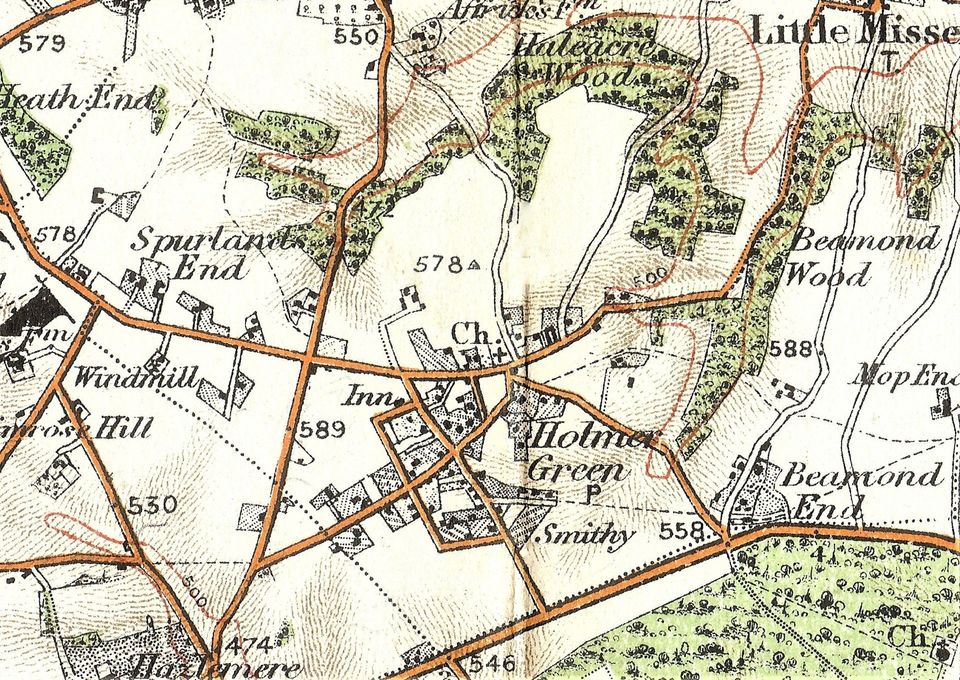The Common
Holmer Green Common
The site of the original medieval manor house of Holmer remains obscure, although local historians McLain-Smith and Riches have suggested its location at a moated site in nearby Colemans Wood where they have excavated medieval pottery.[citation needed]
The oldest houses are The Old Rookery, Hollands Farm and Penfold, all of which probably date from the early 16th century when the hamlet thrived due to sheep farming.
The village underwent housing development during the 1960s and early 1970s and now has about 4,000 inhabitants (almost double that of nearby Great Missenden).[3] The big developments of the 1960s and 1970s included an expanded range of shops around Turners Place, the Winter's Way estate, the Fox Road and Harries Way estate and the Holmer Court estate (Clementi Avenue). A significant number of newcomers to the village came from Middlesex during that period.
The village has two centres: a commercial centre based around the shops and central crossroads; and a community-oriented centre based around The Common featuring two churches, the village hall, a school, a pub, a children's playground, and The Common itself.
Holmer Green's most desirable roads range from older roads like Watchet Lane and Penfold Lane through to newer developments like Mead Park. The village's most famous residents are television presenter Fern Britton and her husband, celebrity chef Phil Vickery.
Residents jealously guard the village's independence from the Wycombe-based urban sprawl next door. Maintenance of an independent community separate from the Wycombe conurbation has been helped not only by the village's historic connections with the Missendens, Penn Street and Amersham but also by the presence in the village of a full range of amenities including: pre-schools; primary and secondary schools; three different Christian denomination churches (Church of England, Baptist, Methodist); a GP practice; a dental practice; three pubs (The Bat and Ball, The Earl Howe and The Old Oak); two clubs (The British Legion and the Holmer Green Sports Association); and significant sports facilities.
The Village has the benefit of a large enclosed Common which includes a further enclosed children’s play area. A visiting fair is held on The Common in May and September every year. Holmer Green Sports Association provides facilities for tennis, football, cricket, squash and short mat bowls and the High Wycombe Model Engineering Club.
After the First World War rapid expansion took place with many of the men working in the local furniture trade plus some casual cherry picking in the summer, many of the women were engaged in tambour beading to supplement the family’s income. In the early 1920s travel became easier with the introduction of the first motor busses to High Wycombe. After World War 2 Holmer Green again began to expand with many housing estates being built on farm land and derelict cherry orchards, much of this occurred from the mid 1960s, through the1970s and 80s.
It could be said that our hill top village has two main centres with the first being around the cross roads with our ancient pond and shops. The attractive and busy area of the Common provides the second focal point. Around its three sides one can find the Middle School and Baptist Chapel while the Bat and Ball stands proud on one corner overlooking the children’s playground. The Church community hall lies adjacent to Christ Church which modestly dominates the skyline with its high perched golden cockerel weathervane. The main village hall known as the Village Centre evolved from the Victorian school. Continuing around the Common is the original Baptist Chapel now converted to a dwelling. To complete this perambulation we pass the Clementi estate that in the 1970s replaced the country house known as Holmer Court and home to Sir Cecil and Lady Clementi.
We have a thriving village community with many social organisations, we have three churches, thee pubs, three community halls, a sport centre, a range of shops and two garages. With a population of just over 4,000 our Chiltern hill-top village of Holmer Green still retains a very strong village identity and community spirit.
The first real glimpse of our village as a whole is through the 1742 map of the Manor of Holmer where we see a very open landscape with ancient woodland on the outskirts. We also see an established but scattered settled population. Most of these inhabitants would be involved in farming and general rural pursuits. We see the first evidence of fruit growing and in some of the place names much evidence of sheep rearing and droving. We can also identify some of the buildings that survive to this day. This 1742 layout of the village remained almost unaltered until Holmer Green was enclosed by act of parliament in 1854 when the road lay-out we know today was introduced. Although scattered, the inhabitants formed a cohesive community as evidenced by the early establishment of a Baptist and Methodist Chapel plus a school.
Maps of Holmer Green
Below are Maps of Holmer Green from 1742, 1822, 1824 and 1902.
Holmer Green Village Society
PO Box 1283, High Wycombe HP15 6YF.
PO Box 1283, High Wycombe HP15 6YF.






